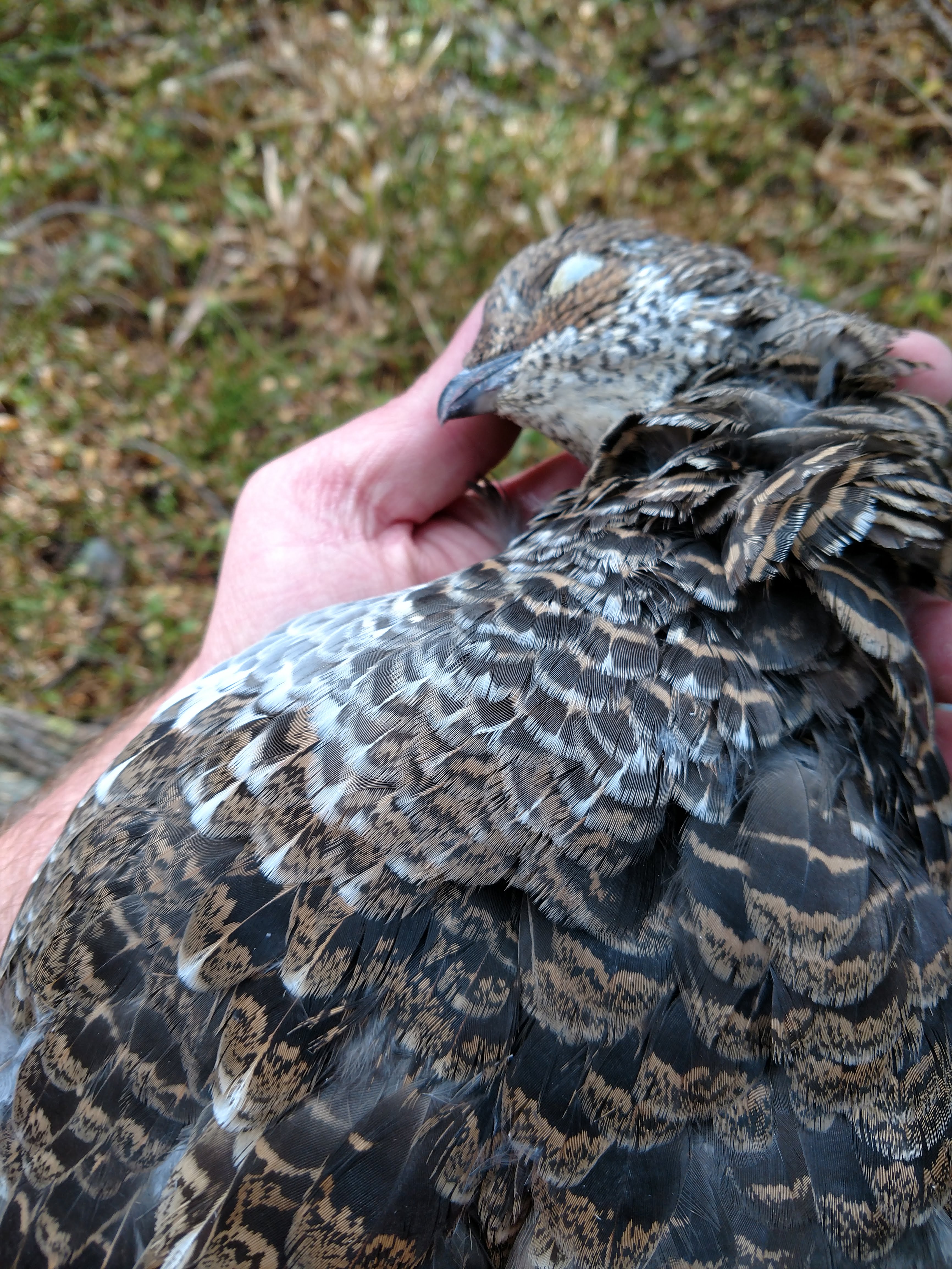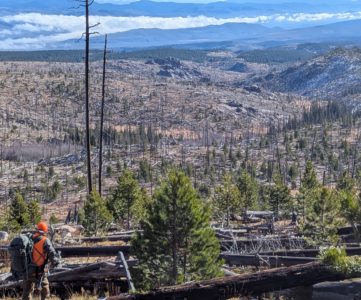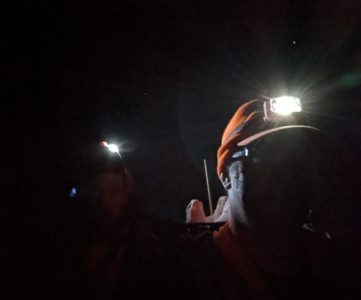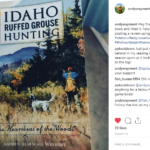Since we moved out to Colorado this summer I’ve been pouring over the Colorado Parks and Wildlife regulations to see what upland birds were available. For now the big game tags seemed out of reach. While Colorado is one of the most popular non resident hunting destinations, the tags have prices that help the economy make the most of the foot traffic on public lands, with a non-resident over the counter elk tag costing $661 this year. For me, a combination tag of small game and a fishing license for $100 was a much easier pill to swallow, and the amount of miles I put on even for small game would easily help me scout for all manner of big game animals while getting something to fill my freezer.
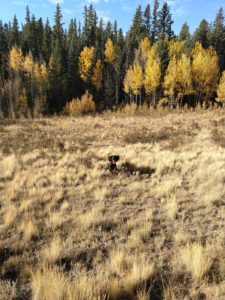
The author’s Gordon Setter Abbey erm… frolicking in the stubble coming back from her cast toward the aspens.
I’d set aside a four day weekend to spend in the woods, and I wanted to split the time between running the dogs and spending some quality time hiking our new backyard with my wife. It was Monday now, and we’d been all over the Pike National Forest — people were beginning to go back to work, and I woke up before most sane people for work, and sometimes even earlier when there was hunting to do. The previous day we’d gone out in search of grouse and wanted to do a little bit of Rocky Mountain leaf peepin’. Sometime between the last week and this weekend the aspens had gone from peak color to having a windstorm knock them around quaking them nearly bare. On Saturday we took our dogs to spend time chasing the tweety birds and enjoy the time outside, the cowbells on their neck playing sweet music to my ears, but our little setter Lily in her zeal had never encountered barbed wire fencing that both myself and my older setter Abbey were used to. Running full tilt through the fence the gashed her shoulder above her Sylmar Kevlar vest and ended up going hard enough to split one of her paws at the webbing. We didn’t notice until that evening, but with her injuries she might have to be out the better part of this season. If she can’t keep from tearing the wound open she might have to have stitches or at the very least wear some sort of boot for a while. We didn’t find any grouse that day, nor any doves, the only other bird in season my dogs had a reasonable chance at pointing or retrieving. The country was beautiful, the walk was nice, but I’d still not seen a single blue grouse since I’d flushed one two weeks ago — and when we originally saw a family group of five in the area some five weeks ago.

Lily posing with her bandaged paw. She’s down but not out. We’re keeping an eye on her paw, she ripped the webbing between her middle two toes and keeps ripping it open due to activity.
I’m a ruffed grouse hunter from Pennsylvania, used to the thunderous takeoffs and the long awkward pauses between working a cover and stopping to talk to a buddy or adjust your dog before the explosive flight of one of the most challenging game birds. I’d been told that the ruffed grouse weren’t very numerous in Colorado, and in fact there was no open season on them in the regulations for Colorado Parks and Wildlife. Having spent time with some westerners at work they told me that these local blue grouse were shot on the sides of the roads, with bow and arrow, and even that a slingshot was a legal method of take! People raised an eyebrow when I mentioned here that I was a die hard grouse hunter. I figured even if dusky grouse weren’t that entertaining to hunt like everyone seemed to tell me that I would at least find a few, bag some, enjoy the experience and then move on to something more challenging. I took the following Monday off of work to hunt and enjoy empty trail heads and light traffic heading into the mountains in the early hours.
I woke up the next morning and started arranging gear, ready to take our Gordon Setter Abbey into the woods with me. I knew that I’d be going high altitude since we’d hiked an area on Sunday that another hunter took a shot right over our heads on a flushed blue. We were close enough to hear the crack-pew of an inbound shot and despite wearing blaze orange and hiking on the trail while not hunting. The sound indicated that it was both close and headed towards us. He got the grouse, and announced it to the world with a hoot and a holler, we just smugly hustled on and I made a mental note to come back when there weren’t side-by-sides and quads racing up and down the OHV road, hunters making figure eights, and mountain bikers enjoying the single track. I pulled my stuff together that morning and was enjoying my last cup of coffee at home when Abbey started vomiting, “that’s the second time” my wife said. She was a 70 pound setter and prone to eating and drinking way too quickly, so I figured it must be just that. For an hour we observed the dog, feeding her again and walking her around to do her business enough for me to chalk it up as a fluke but to also keep her home for the day. She was in good spirits, willing to eat, and not too hot or cold so I filled her bowl and told her to watch her gimpy little sister for the day while I hunted.
The car ride to the mountains, fighting the Denver C-470 beltway traffic, was now approaching rush hour status as the sun was much higher than I’d anticipated. It was still early morning but I was both worried about Abbey and irritated I hadn’t achieved escape velocity from the city below the Front Range that I’d moved to just two months before. The drive, despite the traffic went quickly. It’s about 90 minutes to a small mountain town that Pike National Forest envelopes with public land access in all directions, it has everything you could possibly want unless you’re after gasoline — for that you have to go fifteen miles in either direction to find a functioning gas station, but I always top off before coming over a pass from one direction or the other. From the mountain town in the high plains I quickly turn off and the road goes from state maintained blacktop to dirt immediately, and then we climb and climb and climb to the treeline. Thankfully after nearly getting shot at just a few days ago, I’d marked the spot on the GPS as somewhere that might be interesting, and there was a trail head at the tippy top of the mountain, meaning that there’d be extremely limited climbing involved. After the last few weeks of doing it the hard way this seemed like a no-brainer to me.
I pulled into the trail head lot, if you could call it that, as the wind whistled and gusted. I felt like I was on the top of the world up here. The cover still doesn’t have a name, but Top of the World seems fitting until I hunt a Colorado 14er. I wanted to hunt the treeline in a loop alongside but just off from the trail, descend into a valley that was patchy with pines and a sort of yellowing ground cover that looks like it could have been in the blueberry family. I walked slowly, dropping in from the trail to the pines, scanning side to side. I’d looked at several books and online to know for sure what it was that I was actually hunting. Having never seen a grey jay back east, I felt like this new locale had me practicing my trigger discipline at insane levels — with somewhat large non game animals being present everywhere. I brushed through the pine boughs thinking to myself that there weren’t nearly the amount of tangles of grapes and blackberry brambles that made this solid grouse country — but that was ruffed grouse. Blue grouse are reverse migrators, when the weather gets colder they have a tendency to move higher into the mountains and eat the berries as well as tips of conifers that grow around the tree line. I’d poured over every article I could get my hands on, seeing no real definitive text on hunting blues. I suppose I’d have to figure it out myself, but with the knowledge the birds were in this area of the mountain I felt well armed.
Walking down the trail until there was a break in the treeline allowed me to cover some distance and get into what I thought would be ideal territory. Sneaking slowly, knowing that the hunt while dogless would be just as much about the sights as well as the sounds I was careful to scan each time that I stopped. Having moved from essentially sea level I needed to take frequent breaks anyway at over 12,000 feet in elevation, so I told myself it was to look for those camouflaged forest chickens. Breaking into a small field filled with scrubby cover I spent some time scanning before I caught movement off to the right. Taller than I’d expected, a large grey male dusky grouse was strutting his feathers in the sunlight making him look like a cross between a pigeon and a chicken. Being a wing shooter I did my best to slowly walk up on it, only to have it strut off like a chicken. When I finally was able to get it to flush I whiffed the shot as it flew down over the ridge line. “Well, they’re here” I muttered to myself, hoping that I’d be able to find him or some of his pals.
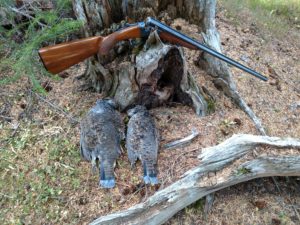
The author’s 1960’s era Ithaca SKB 100 with his pair of dusky grouse from the Pike National Forest.
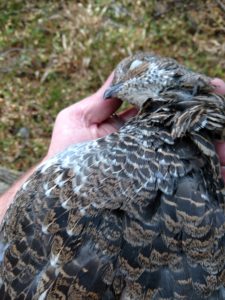
A prized possession, this dusky grouse took several outings in the woods to reliably find, then several more to bag his double.
I checked my GPS, and I hadn’t wandered all that far from the truck just yet. I dropped down to the next thick line on the topographic map I’d kept on my phone, choosing to walk that line as it seemed to be where the grouse had gone. There was a bit of adrenaline, even if it was just a bird, it was something that I was hunting, there must be some sort of natural reaction when a predator sees its prey. Maybe it was just the altitude. I wandered further down the ridge, the fallen timber dry from the exposure to the Colorado mountain air, it sounded like stepping on potato chips as I stepped on errant branches. The wind up at elevation had to have been killer, there was windfall timber everywhere. Huffing and puffing I stopped for a moment, taking a sip of water and looking scanning the treetops for a dusky grouse that might be sitting in the pine trees trying to escape the wind that was kicking up just a little bit now. I shifted my feet on the uneven ground sighing since I’d not seen a bird or anything other than a squirrel for about a half an hour. It was hard to transition from the Ruffed Grouse coverts that I knew so well to out here, the west, where I was just beginning to learn what I was doing. Just then there was a little scratching dead ahead. I noticed the two females first, and then a large male grouse scratching at the ground. I flicked the safety off on my Ithaca SKB 100, knowing they had not yet registered my presence. I took several slow steps towards them, raising my gun from port arms to the shoulder as they flushed. In a second the male flew to the right and the two females flew left, an unseen large grouse burst from the treetops making an incredible racket. I swung on the two females and emptied both barrels, allowing the 2o gauge to bark rapidly. I dropped both birds, my first grouse double ever. One flapped slightly as I walked over to retrieve it, wishing that Abbey and Lily had been here and pointed the birds. It just felt wrong to have taken the birds when such talent was laying at home, knowing full well the blaze orange and gun had left early that morning. I looked around, thinking that perhaps I’d only winged the second bird when I found her piled up below the tree where they’d been feeding.
I picked up the birds, admiring their feathers, greys, browns, and white throughout. It was unmistakably a grouse, but the grey white band across the fan tail was something I wasn’t quite expecting. The bag limit for Dusky Grouse is three birds, but at this point today I wasn’t sure that I could do much better. I’d moved five grouse and dropped two. I looked at the GPS again and decided I’d take this elevation line to the nearest trail and hike back uphill to the truck. If I found another bird I’d have to make the spot decision as to whether to shoot, but with the weight of two birds in the game bag I was more than satisfied as I huffed and puffed towards the truck.
The weather began to turn and the clouds were visibly grayer than they were just moments before. The pine forest seemed much darker, making me understand what they meant by “dark timber” for the first time. It was sleeting off and on, little granules of ice coating my black wool pullover and then quickly melting. It was chilly, but even at the top of the mountain it was a bit brisk at 45 degrees. The sleet began to worsen and I looked at my GPS seeing that I had already began to angle in my loop back towards the truck. Hustling through the woods and thinking of my sick dog at home I knew that I didn’t want to be at the top of the Continental Divide when a real mountain storm hit, and the roads started snotting up before I was able to get out of there. Earlier in the spring I’d had an episode with my Jeep where I went to shift on a gravel road in the Allegheny National Forest when suddenly my truck acted like it was in neutral, engine roaring at the gas pedal — the shifters ineffective and flopping around like a dead fish. The plastic linkage had broken, sheared completely off from the transmission to the shifters. It was now held in place, and had been for months with bailing wire. Literal bailing wire. Who knows how long before the moisture would eat through it and there’d be yet another situation. My mind raced as I got to the truck through the woods, not running by a long shot but quickly.
There’s not much running to be done at 12,000 feet for me. I cased my Ithaca and took off my vest, glasses fogging up with the heat from my body and the cooling mountain air, and I slipped inside the truck to throw on the defrosters and check my cell phone for the last time I’d have service reliably in nearly an hour of travel. I looked up briefly after tapping out an email and sending it, the clouds swirling around and the sleet coming in waves now when something in my peripheral caught my eye, and I saw a small band of mountain goats coming out of the exposed high country headed past my truck and down into the dark timber. My luck sure had changed in just a couple weeks. Sure, I was a fool, but I had found my hens.

Mountain goats coming out of the high country seeking shelter in the dark timber.

